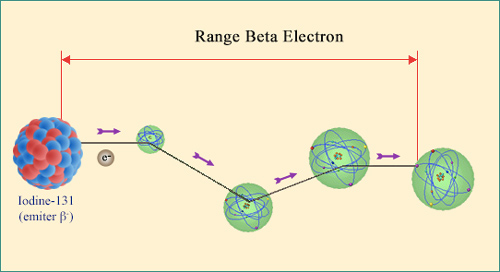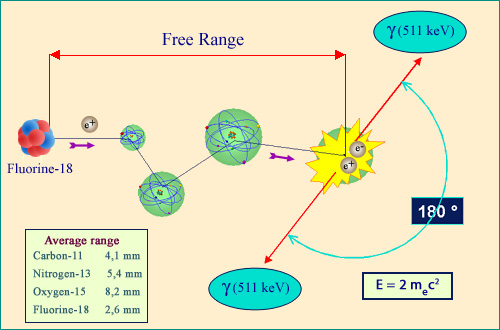Light electrons : a chaotic journey through matter

Trajectory of a beta electron
The path of a beta electron emitted by a nucleus is long and chaotic. Like an alpha particle it is slowed down by ionisation but due to its tiny mass often undergoes deviations at large angles when it collides with heavy nuclei. Once most of an electron energy has been lost, it melts into the crowd of other electrons and eventually joins the existing atom cohort of orbiting electrons.
© IN2P3
Beta electrons and positrons have equal and opposite electric charges. They are both emitted in the course of radioactive decays at speeds approaching that of light, and are therefore much faster than the heavier alpha particles.
A beta particle loses its energy (i.e slows down) by ripping electrons away from the atoms it passes: in other words, it ionises matter all along its trajectory. Hoxever, the path of an electron or positron differs dramatically from that of an alpha particle, whose mass is over 7300 times greater. A beta particle electron is indistinguishable from the electrons it interacts with.
When a beta particle and an atomic electron have a head-on collision, it becomes impossible to distinguish between the two particles and the energy is shared between the two miniscule, identical corpuscules. The nuclei approached also the paths of beta particles also help slow them down, by causing the emission of a gamma photon owing to their strong electromagnetic field (known as a braking photon – Bremsstrahlung in German) which takes away a share of the beta particle energy.
When all is said and done, beta particles are less ionising than alpha particles, and their paths are random, long and sinuous. Beta radiation may be more penetrating, but its energy is deposited over a longer distance and is therefore less harmful in case of absorption. The differing levels of penetration can be shown in that alpha particles are stopped by human skin whereas beta particles can travel straight through. It takes up to three metres of air or seven millimetres of aluminium to stop the fastest of these particles.

Birth, life and death of a positron
The trajectory of a positron emitted by a nucleus starts off in the same way as that of an electron. It is slowed by ionisation and deflected by collisions with heavy nuclei. Finally, however, when its speed is greatly reduced, a positron disappears in an annihilation collision with an atomic electron. Mutual antiparticles, the positron and the electron are entirely converted into energy. The released 1 MeV energy is carried away by two gamma photons, travelling in opposite directions.
© IN2P3
The end of a positron path differs slightly from that of an electron, even though up to that stopping point their behaviours are almost identical. The difference is that when an electron loses all of its energy, it melts into a crowd of other, indistinguishable, electrons. A positron, however, will disappear.
This is because the positron, being a particle of antimatter, will find itself attracted to a electron. Pulled in by the opposite charges, the two particles will revolve around each other until they finally make contact. They will then mutually annihilate, releasing in the process almost a million electronvolts of energy which take the form of two gamma particles emitted back-to-back.
This classic signal of a positron disappearance has a wide range of medical applications, most famously in positron emission tomography, commonly known as PET.
NEXT : Bremsstrahlung
Other articles on the subject « Radiations effects in matter »
Charged Particle Effects
A gradual loss and transfer of energy Alpha rays, fission products ; heavy, slow and ionizing par[...]
Alpha Rays in Matter
An atomic bulldozer, strongly ionizing along a very short path Alpha particles are simultaneously[...]
Bremsstrahlung
A relativistic phenomenon that applies to electrons and positrons… The phenomenon of bremss[...]
Neutral Particle Effects
Energy transfer by proxy… Neutral particles that are of interest in the field of radioactiv[...]
Cherenkov Effect
When an electron goes faster than light in air and water … The Cherenkov effect occurs when[...]
Cross Section
Cross section or the interaction probability of a particle Cross section is the name given by phy[...]
Gamma Rays in Matter
Gamma can be attenuated but never fully stopped The neutral gamma rays leave very different effec[...]
Photoelectric Effect
The most effective mechanism of photon absorption The photoelectric effect is the phenomenon that[...]
Compton Effect
Photons as projectiles and electrons as targets The Compton effect is the name given by physicist[...]
Macroscopic Effects
Effects on inert or organic matter The ionisation of atoms surrounding the trajectory of an alpha[...]